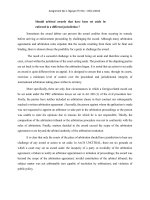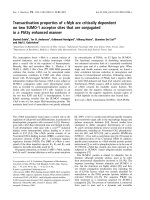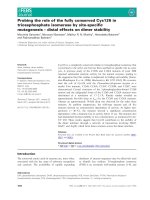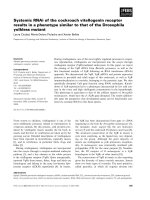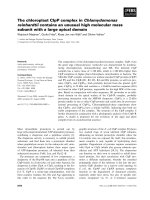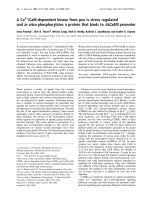mass balances in a dam that receives mine drainage
Bạn đang xem bản rút gọn của tài liệu. Xem và tải ngay bản đầy đủ của tài liệu tại đây (302.13 KB, 4 trang )
Available online at www.sciencedirect.com
ScienceDirect
Procedia Earth and Planetary Science 17 (2017) 710 – 713
15th Water-Rock Interaction International Symposium, WRI-15
Mass balances in a dam that receives mine drainage
Bravo-Covarrubias Américaa,1, Cano-Rodríguez Ireneb, Jofre-Melendez Rodolfoa,
Gutiérrez-Valtierra Moisésb, Ramos-Arroyo Yanna
b
a
University of Guanajuato, Engineering Division, Juárez Av. 77, center, Guanajuato, Gto., 36000, Mexico
University of Guanajuato, Division Ciencias Naturales y Exactas, Noria Alta S/N, Guanajuato, Gto., 36000, Mexico
Abstract
This work focuses in a small reservoir named The Santa Ana dam that receives abandoned mine drainages since 200 years ago. The
presence of calcite in fractures of local rocks maintains an alkaline pH in all the mass water. Oxygenation condition inside reservoir
is almost constant. According to the bathymetry, the mass balance displays a variation of properties which are seasonally controlled
by hydrological events. High loads of elements were detected in solution during dry season (November 2015): sulfates present a
load of 11,378.65 tons, confirming that main inlets in the reservoir are mine drainages. The Arsenic has a similar behavior: a
greater load in solution during dry season, with 9.85 tons compared with other periods (less or equal to 0.5 tons). The greatest loads
of iron and manganese are present in rainy season (20.43 and 9.15 tons respectively). This suggests the existence of a mobilization
of precipitated minerals on the channel that feeds the mass water and reach the bottom of the reservoir where reducing conditions
are dominant, favoring their release to the aqueous phase. Oxygen concentration decreases by half between the seasons due to
organic matter oxidation. This trend continued in November, because quantities in solution were very high.
© 2017
2017The
TheAuthors.
Authors.
Published
by Elsevier
Published
by Elsevier
B.V.B.V.
This is an open access article under the CC BY-NC-ND license
( />Peer-review
under responsibility of the organizing committee of WRI-15.
Peer-review under responsibility of the organizing committee of WRI-15
Keywords: Arsenic mobility; abandoned mine; hydrogeochemistry.
1. Introduction
Mining and processing of sulphide ore generates great amounts of material which produce severe impacts on
water resources. Metal sulphide deposits contain significant amounts of economically important metals such as: Au
and Ag which can also be found as native elements; however, metals such as Cu, Ni, Zn, Pb are present1. Sulphide
minerals are main sources of potentially toxic elements, including: As, Se, Cd, Sb and Hg and in some cases of
acidity, being pyrite the main source. Abandoned mine works in this region generate leachates with high
*Corresponding author. Tel.: +52 473 1020100 ext 5904.
E-mail address:
1878-5220 © 2017 The Authors. Published by Elsevier B.V. This is an open access article under the CC BY-NC-ND license
( />Peer-review under responsibility of the organizing committee of WRI-15
doi:10.1016/j.proeps.2016.12.167
Bravo-Covarrubias América et al. / Procedia Earth and Planetary Science 17 (2017) 710 – 713
concentrations of solutes, mainly sulfates, about 1,000 mg/L2 and potentially toxic substances (PTS) in higher
concentrations.
Balance of solutes produced trough sulphides oxidation can be used to estimate rates of the processes and
estimate a hydric balance3. Comparing this information with laboratory studies and the baseline, is possible to define
the intensity of quality affectation. The dissolved constituents in natural waters are released through geochemical
weathering facilitated by microbial processes3. PTS are transported in aqueous or particulate phase.
Affectations of mine drainages will be reflected in: high concentrations of metals and metalloids, pH (accord
mineralogy), and content of sulfates. This situation will be observed in the currents of rivers, streams, lakes, which
are affected by mine drainage.
For the spatial and temporal variations of properties of source waters, regular monitoring programs are required to
estimate the available volume considering drinkable water 4. Monitoring water quality is a useful tool not only to
assess the impacts of pollution sources but also to ensure efficient management of water resources 5. This work
focuses on the spatial and temporal description of the chemistry of a small reservoir (50,000 m3) in Guanajuato city
(Figure 1). The reservoir receives drainage of at least 5 abandoned mines, and there is a plan to expand the storage
volume and use for population supply.
2. Material and methods
2.1 Sampling strategy
The study was developed during the period of December 2014 until November 2015 during four dates: December
2014 (I), February 2015 (II), September (III) and November (IV). Water samples were collected considering the
effect of the reservoir geometry in the parameters to be measured. The different sampling points considered can be
appreciated in Figure 1, the body of reservoir was divided by segments from 0-7, with 0 being in dam; sampling
points are located in the changes of direction in the flow of the reservoir. At each point, samples were collected
both at surface and depth to compare variations between oxic-anoxic environments.
2.2 Water sampling and analyses
Samples were collected in polyethylene high-density bottles previously washed with diluted nitric acid and rinsed
three times with distilled water. Also, at the site bottles were rinsed three times with sampled water. Samples were
filtered by Whatman No 4, and alkalinity was determined by volumetry with 0.1 N sulphuric acid. Sulphides, Fe 2+,
and Mn2+ was quantified by spectrophometry with a Hach DR-2800 equipment. A 50 ml aliquot of each sample was
filtered with Millipore membranes of 0.22 μm pore size and acidified (pH= 2) with a drop of concentrated HNO 3 for
cation and arsenic analysis in Atomic Absorption.
2.3 Hydrodynamical model
To consider aspects as residence time and the mix of different mass water: storage volume and runoff divided in
baseflow (with an important component of mine drainage) and storm runoff, the CE-QUAL W26 code was used.
The adaptation of the code considers a rain-runoff model and the description of bathymetry. Figure 1 is a
representation of the geometry of the reservoir.
3. Results and discussion
In Table 1 measured values are presented. Electric Conductivity (EC) shows higher values at the entrance of the
dam as well as at depth, near the sediments, and is possible to detect a trend of decreasing of EC along the reservoir.
Sulfates are present at greater concentration at the inlet and surface, while depth has very low values.
711
712
Bravo-Covarrubias América et al. / Procedia Earth and Planetary Science 17 (2017) 710 – 713
Figure 1. Location of study area.
Figure 2. Representation of residence time of mass water inside the reservoir.
Table 1. Maximum permissible limits of parameters analyzed.
Analyzed parameters
Maximum Permissible
Limit NOM-1277
Average (maximum and
minimum)
Standard Deviation
% samples exceeding the
maximum permissible
N=50
pH
Electric Conductivity
Fe
Mn
SO42NO3S2As
6.5 - 8.5
1200 μS/cm
0.3 mg/L
0.15 mg/L
400 mg/L
10 mg/L
0.05 mg/L
0.025 mg/L
8.56 (10.02-7.46)
665 μS/cm (940-360)
1.68 mg/L (12.7-0)
0.23 mg/L (2.1-0)
219 mg/L (557.13-24)
7.3 mg/L (22-0)
0.107 mg/L (0.980-0)
0.008 mg/L (0.034-0)
0.592
201.7
2.97
0.40
135.63
7.15
190.3
9.5
30
0
35
21.7
7
27
33.33
8.3
Table 2. Mass balance of some parameters (in tonnes) according to the bathymetry of the reservoir and sampling periods.
I (Dec 2014, N=19)
II (Feb 2015, N=9)
III (Sept 2015, N=11 )
IV (Nov 2015, N= 11)
Bravo-Covarrubias América et al. / Procedia Earth and Planetary Science 17 (2017) 710 – 713
O2
Fe
Mn
SO4
As
Ca
306.12
11.65
2.49
9122.3
0.52
4913.8
311.21
3.70
5.53
14430
0.37
7188.12
159.16
20.43
9.15
1940.2
0.23
7970.14
151.12
9.84
3.50
11378.65
9.85
5997.53
Table 2 display a mass balance representation derived from measured values and bathymetry. Is possible to
appreciate that oxygen diminishes by half (that means periods I and II have dissolved oxygen concentrations of 9.5
mg/L and decrease to 5 mg/L in periods III and IV). The reservoir has a considerable level of sediments and high
organic matter content (10.6%-1.6% an average of 5.8%) and consumes dissolved oxygen.
These observations suggest that sulphate-reduction processes can be occurring. Fe and Mn was find at high
concentrations at depth. Sulfates are present in greater concentration at the inlet and surface, while depth has very
low values, this can be explained because under reducing conditions this species is transformed to sulphides, which
is ratified with a high presence of sulfides in the bottom and practically null in surface. Nitrates are mostly presented
in depth and are observed in a greater amount in rainy season. Arsenic is seen in higher concentrations at inlet and at
depth, possible reason for this is its liberation from oxides that reduces at sediment conditions.
4. Conclusions
Geochemical processes occurring in a water body are controlled by several factors which interact with each other.
The study reservoir contains a relatively small mass of water, the presence of oxygen is high, with a relatively short
residence time (60 days to hours, accord Figure 2). Although the oxygen reaches the sediments, it is consumed
quickly by the organic matter and a reducing environment generates, which favors the mobility of As, Fe and Mn.
Acknowledgments
This work is done with the participation of Ms. América Bravo as part of her Ph D. thesis. The authors wish to
thank CONACYT and the University of Guanajuato for their financial support for this line of research.
References
1. Lindsay, M.B.J., Moncour M. C., Bain J. G., Jambor J.L., Ptacek C. J., Blowes D. W. 2015. Geochemical and mineralogical aspects of sulfide
mine tailings. Applied Geochemistry Vol. 57, 157-177.
2. Ramos, Y. R., Muñoz, D., Rodriguez, I., Jimenez, G., Ramirez V. & Martinez J. C. 2010. Detrimental effects of mining on water quality in a
small catchment of Guanajuato, México. WRI -Birkle & Torres Alvarado 2010. Taylor and Francis Group, London, 547-550.
3. Nordstrom, D.K., 2011. Hydrogeochemical processes governing the origin, transport and fate of major and trace elements from mine wastes
and mineralized rock to surface waters. Appl. Geochem.
4. Singh, K. P., Malik, A. Mohan, D., Sinha, S., 2004. Multivariate statistical techniques for the evaluation of spacial and temporal variations in
water quality of Gomti River (India) – a case study. Water research Vol. 38-18, 3980-3992.
5. Strobland, R.O., Robillard, P.D., 2008. Network design for water quality monitoring of surface freshwaters: a review. Journal of
Environmental Management Vol. 87, 639-648.
6. Cole, T.M., Wells, S. A. 2008. "CE-QUAL-W2: A two-dimensional, laterally averaged, Hydrodynamic and Water Quality Model, Version
3.6," Department of Civil and Environmental Engineering, Portland State University, Portland, OR.
7. Norma oficial mexicana nom-127-ssa1-1994, "salud ambiental, agua para uso y consumo humano-limites permisibles de calidad y tratamientos
a que debe someterse el agua para su potabilizacion".
713
